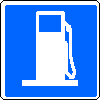 To
Next Fuel (LNG)
To
Next Fuel (LNG)Home - Background: Fuel Types - CNG
Fair warning: I am much more familiar with CNG than with any other alternative fuel, having owned and driven vehicles that use it since 1993. So you might want to de-weight some of the extra enthusiasm I show on this page relative to other fuels!
Natural gas is, well, natural gas--the same stuff that heats your stove or your house. It is largely produced domestically in the United States; it can be imported through pipelines or as a cryogenic (super-cold) liquid on special tanker ships, but because this is a lot harder than pouring crude or refined oil into a tanker or a pipeline, we haven't built up an import dependency for natural gas as we have for petroleum. (Interest in imported natural gas is growing, however, as domestic production has lagged behind increasing demand for this clean fuel.)
Natural gas is distributed nationwide through an extensive network of pipelines, which feed electrical generation plants and domestic and industrial heating uses. Thus the use in vehicles of natural gas is "piggybacking" on many years of infrastructure development.
In order to store a reasonable amount of fuel (i.e., enough to drive a reasonable distance before refueling), natural gas has to be compressed to around 200 times atmospheric pressure--or even more for the tanks aboard large buses! This is like the pressure a mile and a quarter under the ocean, and requires special compressors to be "tapped into" the pipelines. When I bought my first CNG-powered vehicle in late 1993, I had to drive 35 miles roundtrip to the nearest public refueling station; now there is a station less than two miles from my job, so these refueling stations are becoming more common, and not just in Southern California. There are enough nationwide now that I was able to drive Clean Across America And Back in August 1998! In addition, there are home refueling appliances (from FuelMaker Corp.) now available that tap into your domestic natural-gas and electrical lines and slowly refuel your vehicle overnight, so you wouldn't need to use public refueling stations very much at all if you typically drive less than one or two hundred miles a day.
Compressed natural gas is like liquefied petroleum gas (LPG) in many ways, only more so. It is very easy on the engine, giving longer service life and lower maintenance costs. CNG is the least expensive alternative fuel (except electricity) when you compare equal amounts of fuel energy, and, in my experience at least, its price has been relatively steady (except for one big jump when California utility regulators changed the rules!). At the peak of the big gasoline price run-up in April, 1996, I was paying half as much for a gasoline-gallon-equivalent of 130-octane natural gas as I would have paid for a gallon of 92-octane unleaded gasoline! Even with the natural-gas price spikes of the last few years, I have found the price of CNG to be less volatile, and on average lower, than that of gasoline.
The high octane rating of natural gas allows the CNG-powered Honda Civic GX to use a very high compression ratio and produce more power than stock gasoline versions. My own van has a stock compression ratio and about 10% lower power output than the gasoline version with the same-size engine, but I get significantly better fuel economy on the open road because the high octane rating of the fuel allows timing and mixture to be adjusted for more efficiency without causing detonation ("knocking"). And, as with LPG, because the fuel tanks have to withstand such enormous internal pressures, they are incredibly tough, with good results for safety. In addition, because natural gas is lighter than air and has very narrow flammability limits, if a leak develops it is very likely that the fuel will dissipate harmlessly into the air without causing a danger of ignition or explosion.
Natural gas has, over the course of the 1990's, proven to be the most effective fuel for reducing emissions in an internal combustion engine. The 1993 Dodge full-size CNG vans like mine were the first vehicles to meet the California Low Emission Vehicle (LEV) standards; the 1994 Chrysler/Dodge CNG minivans were the first to meet the Ultra-Low Emission Vehicle (ULEV) standards; the 1997 Ford CNG pickups and vans were the first to meet the Super Ultra-Low Emission Vehicle (SULEV) standards; and the CNG Honda Civic GX has been the cleanest internal-combustion-engine vehicle ever tested by the EPA in every year since its 1998 introduction. There are now a fair number of gasoline-powered vehicles that run cleaner than my van, but it took five years for the first gasoline vehicle to catch up (with a much smaller engine than my van's!), and in the meantime natural-gas-vehicle emissions have continued to plummet.
Again, CNG is like LPG, but more so. The tanks are quite bulky and heavy, about three times more so than LPG tanks (have a look at the photos of my van--the tanks are half-inch-thick aluminum clad with reinforced fiberglass), though modern composite technology is starting to be used to cut weight and cost (as on the Honda Civic GX). Range is significantly less than for an equivalent gasoline vehicle, unless you really go overboard adding extra fuel tanks! And again, mostly because of the heavy-duty tanks, there is currently a large price premium for a CNG vehicle compared to a gasoline version ($3000-5000). The fuel and maintenance costs can be enough cheaper, however (like the first time you don't have to spend $2000 to overhaul the engine!), in a high-mileage application like a transit bus, a taxi, or a shuttle van, that this will repay the higher initial purchase price over time (and, depending on where you live, you can piece together enough federal, state, and local incentive money to cover most of the extra purchase cost in the first place--this was true for me). Finally, the refueling infrastructure is still growing, as noted above.
 To
Next Fuel (LNG)
To
Next Fuel (LNG) Back
to Fuel Types
Back
to Fuel Types Back
to Fueling Station
Back
to Fueling Station Site
Map
Site
Map Contact
Me
Contact
Me All content copyright 1998-2024 by Mark Looper, except as noted. Reuse of my copyrighted material is authorized under Creative Commons Attribution 4.0 International license (CC BY 4.0).
![]()
![]()
new 11 July 1998, revised 21 July 2003